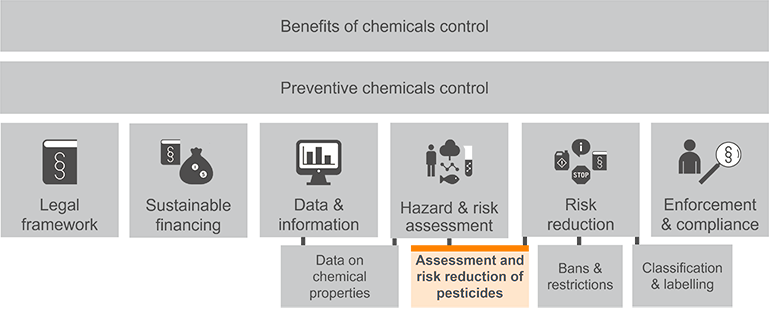Assessment and risk reduction of pesticides
Pesticides need particular attention since they are designed to have effects on target organisms and are deliberately spread into the environment. Use of the most hazardous pesticides should be avoided as far as possible.
Pesticide risk reduction
Pesticides are chemical or biological products intended to prevent or deter animals, plants or micro-organisms from causing damage to human health or property. Due to these properties, pesticides may cause harm to health and the environment. That is why there should be risk reduction measures for pesticides in place.
The Food and Agriculture Organisation (FAO) and the World Health Organisation (WHO) have developed the International Code of Conduct on Pesticide Management, and it serves as a framework on pesticide management for all public and private entities engaged in, or associated with, the production, regulation, and management of pesticides. According to the Code, governments are strongly encouraged to establish regulatory schemes and infrastructures under which each pesticide product is registered before it can be made available for use.
If such provisions are not in place in a country, it is highly recommended to develop that kind of legislation. Which risk reduction measures that can be taken in a country depend on the national legislation.
Read more about the International Code of Conduct External link. on the FAO website.
External link. on the FAO website.
Read more about recommendations on risk reduction in our Guidance on hazard and risk assessment and risk reduction of pesticides.
Highly Hazardous Pesticides
The International Code of Conduct on Pesticide Management defines Highly Hazardous Pesticides (HHPs) as "pesticides that are acknowledged to present particularly high levels of acute or chronic hazards to health or environment according to internationally accepted classification systems such as WHO or GHS or their listing in relevant binding international agreements or conventions. In addition, pesticides that appear to cause severe or irreversible harm to health or the environment under conditions of use in a country may be considered to be and treated as highly hazardous".
Once the use of highly hazardous pesticides has been identified in a country, it is recommended that measures are taken to reduce the exposure. In order to avoid that these pesticides at some point become a problem to the environment or to the society, it is recommended that the pesticide products as far as possible are regulated upstream in the supply chain.
FAO and WHO guidance on Highly Hazardous Pesticides External link.
External link.
Information on pesticides generated in the EU
In many countries and regions, there are systems for authorisation or registration of pesticides. Our guidance document is based on the approach of using information and assessments generated by authorities in other countries or by international agencies.
In EU there is a system for approval of active substances for use in plant protection products. Information about the active substances, their legal status in EU and risk assessments are available in a database online.
EU Pesticides Database, on the website of European Commission External link.
External link.
Biocides, products such as household pesticides and rodenticides, are also assessed and approved in the EU. Information about active substances and biocidal products can be found in a database on the website of the European Chemicals Agency (ECHA).
ECHA's database on biocides External link.
External link.
In our Guidance on hazard and risk assessment and risk reduction of pesticides, you will find more information about the processes and available information in the EU.
Guidance on hazard and risk assessment and risk reduction of pesticides
The aim of this guidance is to provide an overview of procedures and measures for hazard and risk assessment and risk management of pesticides, with a special focus on so called Highly Hazardous Pesticides. The purpose is to help authorities to take regulatory actions to reduce the negative impact of pesticide use on people's health and the environment. The guidance is based on the approach of using information and assessments generated by authorities in other countries or by international agencies.
The guidance covers the following areas:
- The International Code of Conduct on Pesticide Management
- Information on pesticides generated within the EU
- Risk assessment within the EU
- Recommendations on how to identify Highly Hazardous Pesticides
- Recommendation on risk reduction
- Sustainable pest control
Read our guidance on Hazard and risk assessment and risk reduction of pesticides.
This guidance complements the FAO/WHO International Code of Conduct and related guidelines and tools, and the FAO Pesticide Registration Toolkit.
The International Code of Conduct on Pesticide Management External link.
External link.
FAO and WHO technical guidelines on pesticides management External link.
External link.
Tools for implementation of the Code of Conduct External link.
External link.
Credits
Illustrations by Maja Modén.

